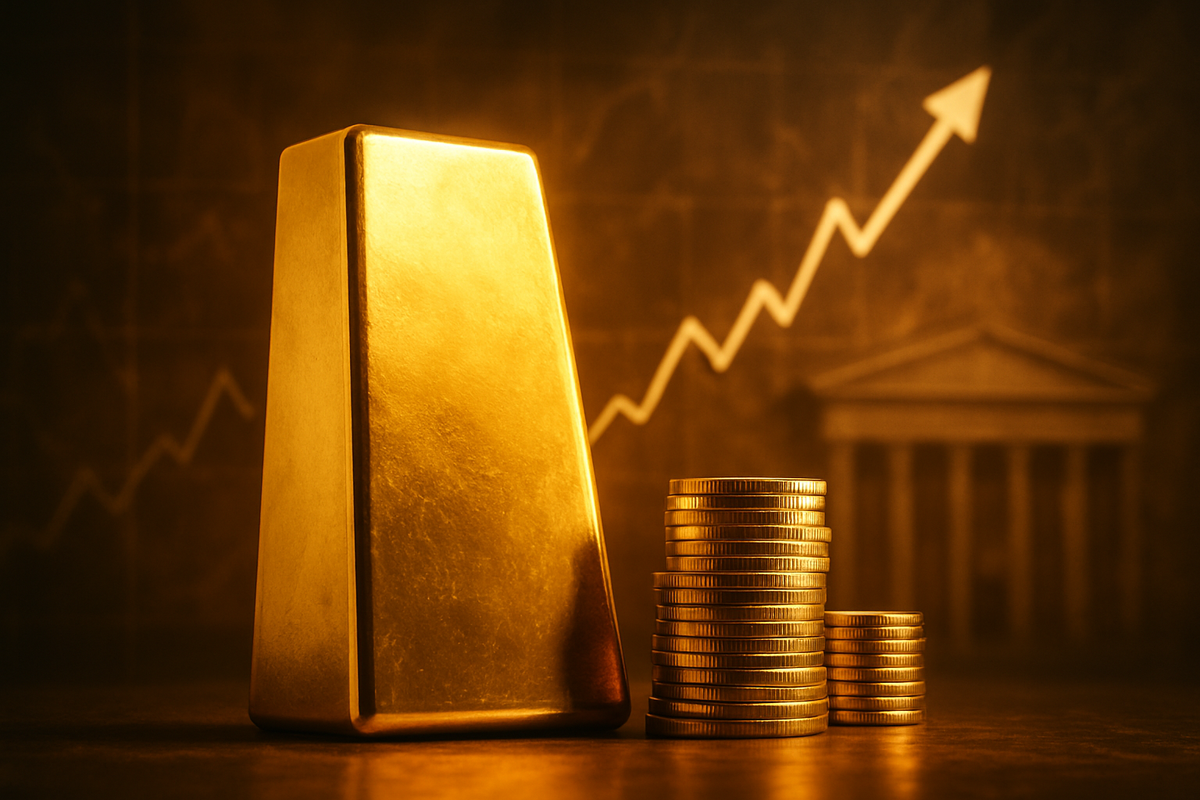
New York, NY – October 30, 2025 – In a hypothetical yet highly plausible scenario unfolding around October 2025, gold prices have surged past the unprecedented $4,000 per ounce mark, propelled by aggressive monetary easing from the Federal Reserve and signals of further interest rate reductions. The yellow metal, at one point, reached an all-time high near $4,381.58 earlier in the month, currently consolidating significant gains around $3,980-$3,990. This historic rally is directly linked to the central bank's actions, which aim to stimulate a softening economy but are simultaneously fueling concerns about inflation and broader economic stability, driving investors towards traditional safe havens.
The Federal Reserve has already implemented a series of rate reductions, bringing its benchmark rate into a target range of 3.75%-4.00% by late October 2025. Financial markets are now anticipating continued accommodation, with some analysts assigning a high probability of another quarter-point reduction. This aggressive dovish pivot comes as the U.S. grapples with a decelerating labor market, economic slowdowns, and even an ongoing federal government shutdown, creating a complex and uncertain economic environment. The immediate implications include increased investment demand for precious metals, robust central bank buying, and a broader rally across the precious metals complex, all set against a backdrop of investor sentiment reflecting both optimism and underlying economic anxieties.
Unprecedented Ascent: A Detailed Account of Gold's Hypothetical October 2025 Rally
The hypothetical surge of gold prices past $4,000 in October 2025 marks a pivotal moment, representing the culmination of several months of compounding economic and policy developments. This monumental rise was primarily catalyzed by a series of aggressive interest rate cuts by the Federal Reserve, enacted in response to persistent economic deceleration and growing concerns over either deflationary pressures or potentially uncontrollable inflation exacerbated by previous fiscal stimuli. The move signaled a dramatic shift in monetary policy, significantly enhancing gold's appeal as a safe-haven asset and inflation hedge.
The timeline leading up to this hypothetical surge would likely begin in late 2024 and early 2025, with mounting economic concerns evident in consistently weakening growth, rising unemployment, and declining consumer confidence, possibly exacerbated by escalating geopolitical tensions. By March-June 2025, the Federal Reserve would hypothetically initiate a cycle of cautious interest rate cuts (25-50 basis points per meeting), adopting an increasingly dovish tone and signaling readiness for further action. This would begin to reduce the opportunity cost of holding non-yielding assets like gold. The pace would accelerate from July-September 2025, with the Fed implementing more aggressive cuts (75-100 basis points) as economic indicators fail to respond, or as inflation proves stubbornly high (or dangerously low). This would lead the market to price in a "lower for longer" interest rate environment, pushing real interest rates significantly negative and intensifying fears of currency debasement or a flight to safety.
The tipping point in October 2025 would involve a convergence of factors: a major Fed announcement of an aggressive rate cut or renewed Quantitative Easing (QE), significant U.S. dollar weakness (the U.S. Dollar Index (DXY) reportedly fell nearly 11% in the first half of 2025), massive safe-haven inflows driven by heightened geopolitical risks and economic uncertainty, and strong momentum trading as gold breached psychological resistance levels (e.g., $2,500, then $3,000, then $3,500), pushing the price rapidly past $4,000. Key players involved would include Federal Reserve officials, whose statements and policy decisions directly influence market expectations; major financial institutions (investment banks, hedge funds) actively trading gold derivatives and equities; gold miners like Newmont (NEM), Barrick Gold (ABX), and Agnico Eagle Mines (AEM), who are direct beneficiaries; central banks globally, consistently increasing their gold reserves; individual investors through physical gold and ETFs; and commodity exchanges managing trading infrastructure. Initial market reactions would see gold mining stocks experiencing explosive rallies, outperforming the metal itself, significant weakness in the U.S. dollar, and intense media and analyst scrutiny debating the sustainability of gold's rally and broader economic implications.
Corporate Fortunes: Winners and Losers in the Golden Era
A significant and sustained surge in gold prices past $4,000 per ounce, primarily driven by Federal Reserve rate cuts, would create distinct winners and losers across various public companies. The fundamental mechanism is straightforward: lower interest rates reduce the opportunity cost of holding non-yielding gold, a weaker U.S. dollar makes it cheaper for international buyers, and economic uncertainty amplifies its safe-haven appeal.
The Winners: Gold mining companies stand as the most direct beneficiaries. Their core business model thrives on higher gold prices, which translate into increased revenues and expanded profit margins, assuming stable production costs. This improved profitability strengthens balance sheets, allowing for debt reduction, increased dividends, or funding for exploration and development projects. Their market positioning is significantly enhanced, leading to higher stock valuations, often offering leveraged exposure to the metal's price.
- Newmont (NEM): As one of the world's largest gold producers, Newmont (NYSE: NEM) would see substantial increases in its realized gold price, driving significant margin expansion, as evidenced by its Q3 2025 realized average gold price of $3,539 per ounce.
- Barrick Gold (ABX): Barrick Gold (NYSE: GOLD) has consistently shown strong correlation with higher gold prices, leading to jumps in net income, operating cash flow, and free cash flow. Prices above $4,000 would continue this trend, bolstering financial health.
- Agnico Eagle Mines (AEM): Agnico Eagle Mines (NYSE: AEM) would benefit from boosted margins and strong cash generation, allowing for debt reduction and strategic investments, solidifying its balance sheet.
- Kinross Gold (KGC): Kinross Gold (NYSE: KGC) has demonstrated its ability to significantly increase adjusted net earnings and improve margins when gold prices rise. Precious metals streamers and royalty companies, such as Royal Gold (RGLD), Franco-Nevada (FNV), and Wheaton Precious Metals (WPM), also benefit immensely. They provide upfront financing to miners in exchange for a percentage of future production or revenue, offering strong leverage to commodity price increases without direct exposure to mining operational costs. Diversified miners with significant gold assets, like First Quantum Minerals (FM), would see their gold segments significantly boost overall profitability.
The Losers: Conversely, certain sectors would face headwinds. Jewelry retailers and manufacturers would likely experience increased raw material costs, which would be passed on to consumers as higher retail prices. This could negatively impact sales volumes, especially in price-sensitive markets, as consumers reduce purchases or opt for alternatives. While luxury brands with strong recognition might navigate this better, companies focused on mass-market or lower-margin items could struggle. Companies reliant on gold for industrial applications, such as those in electronics, nanotechnology, and material science, would also face increased input costs. Manufacturers of high-tech electronic components, for instance, that use gold in connectors or circuit boards, would see their production expenses rise, potentially squeezing margins unless they can innovate in gold usage or pass costs to consumers. Furthermore, financial institutions with negative gold hedging positions or short sellers of gold or gold mining stocks would incur significant losses. If the gold surge is symptomatic of broader, runaway inflation, companies with high input costs that cannot easily pass these costs to consumers could also suffer.
A New Golden Standard: Wider Significance and Historical Context
The hypothetical surge in gold prices past $4,000 in October 2025, primarily driven by Federal Reserve rate cuts, signals a profound re-evaluation of gold's role as a safe-haven asset and a hedge against economic instability. This "golden rally" is rooted in several converging industry trends that underscore shifting investment paradigms. The diminished opportunity cost of holding gold due to lower interest rates, a weakening U.S. dollar (reportedly falling nearly 11% in the first half of 2025), persistent inflation around 3%, and heightened geopolitical and economic uncertainty (including a U.S. government shutdown) all contribute to gold's enhanced appeal. A particularly significant trend is the robust central bank demand, with global central banks consistently accumulating gold, adding over 1,000 tonnes annually for four consecutive years by August 2025, pushing gold's share to over 23% of official global reserves. This strategic de-dollarization provides a strong structural foundation for sustained gold growth.
The ripple effects are far-reaching. Beyond gold, other precious metals like silver and platinum have also seen gains, benefiting from similar safe-haven demand. The gold mining industry, as discussed, thrives on higher prices, leading to increased profitability and potential for expansion. However, this surge also creates challenges for competitors in the safe-haven asset space, such as government bonds, which may see reduced demand. Broader financial markets may see a rotation into safe-haven assets away from riskier investments, with gold's performance outpacing major U.S. stock indices. Partners in the gold supply chain, including refiners and logistics providers, are experiencing increased activity, and the expansion of fractional gold offerings aims to democratize precious metal ownership.
Regulatory and policy implications are significant. The Fed's rate decisions will remain under intense scrutiny, with market participants closely watching for further cuts amidst internal disagreements among officials. Governments worldwide will monitor commodity inflation and its impact on economic stability, potentially influencing future monetary policy. The trend of central banks diversifying reserves away from the dollar could also spark policy discussions regarding international monetary systems. Historically, the current rally shares similarities with the late 1970s and post-2008 financial crisis eras, both characterized by inflation concerns and global instability. However, this rally is unique due to the confluence of aggressive monetary easing expectations, robust central bank demand, geopolitical fragmentation, and a global shift towards de-dollarization. The velocity of its ascent, from $2,000 to over $4,000 in approximately 18 months, demonstrates remarkable momentum, with broad institutional and retail participation. Some analysts even suggest gold is behaving more like a "risk asset" given its volatility, while others declare a new "floor" for its price, projecting sustained moves towards $5,000 per ounce by 2026.
The Path Ahead: Navigating Gold's Future Landscape
Looking beyond October 2025, the gold market and broader economy are poised for a period of continued evolution, shaped by ongoing monetary policy, geopolitical dynamics, and investor sentiment. In the short term, while gold may experience brief pullbacks and consolidation phases due to profit-taking, the underlying bullish trend is expected to persist. Analysts project gold to potentially reach $4,200-$4,400 per ounce by 2026 and even $5,000 by 2030, with some institutions forecasting $4,900-$5,055 by late 2026 under certain scenarios. This continued rally will be primarily driven by anticipated further Fed rate cuts, persistent global uncertainty, robust central bank buying for diversification, and sustained ETF inflows.
For the broader economy, a fragile balance is expected, characterized by mixed signals. Developed markets may experience softer growth in the near term due to the lagged impact of previous restrictive policies, but recession risks are considered low. However, inflation is expected to remain above target in some regions. A weakening U.S. dollar, driven by the dovish Fed, will continue to make gold attractive. Strategic pivots for investors should focus on long-term wealth preservation, viewing gold as a critical component for portfolio diversification (typically 5-10%). Accumulating on dips and considering silver for higher risk/return potential are viable strategies. Investors can gain exposure through gold-backed ETFs, mutual funds, or gold mining stocks. For companies, particularly miners, the environment presents opportunities for margin expansion, capital investment, and production optimization. Portfolio diversification by integrating gold with other metals and continued consolidation through M&A are also likely trends.
Potential scenarios range from "Sustained Accommodation & Elevated Inflation," where the Fed continues aggressive rate cuts, leading to gold pushing towards $4,500-$5,000 and beyond, with moderate economic growth challenged by sticky inflation. Another scenario, "Economic Stabilization & Moderate Inflation," could see gold prices consolidate as the economy stabilizes and inflation is brought closer to target. A more extreme "Politicized Fed" scenario, as warned by some analysts, where the Fed's independence is compromised, could lead to an extreme gold surge towards $5,000 and potentially higher, as trust in the dollar erodes. Overall, the outlook for gold remains predominantly bullish, making it a strategic asset for diversification and wealth preservation.
The Golden Horizon: A Market Assessment and Investor's Watchlist
The surge of gold past $4,000 in October 2025 marks a definitive moment, reinforcing its role as a paramount safe-haven asset in an increasingly uncertain global financial landscape. Key takeaways from this event include the profound influence of Federal Reserve rate cuts in reducing gold's opportunity cost, the significant impact of a weakening U.S. dollar on global demand, the persistent role of gold as an inflation hedge amidst sticky price pressures, and the unwavering demand from central banks diversifying their reserves. This record-breaking performance, with year-to-date gains surpassing 55% by October, signals a broad-based participation in the gold rally, extending beyond retail panic buying to include substantial institutional interest.
Moving forward, the market is currently experiencing some consolidation, but the overarching sentiment among analysts remains bullish, with many projecting gold to challenge the $5,000 per ounce level in 2026. The Federal Reserve's future monetary policy will remain a critical determinant; while further cuts would be a tailwind, any hints of a pause or less dovish stance could introduce short-term downward pressure. However, persistent inflation and robust central bank buying are expected to provide strong underlying support, establishing price floors during corrections. The lasting impact of this surge could be a fundamental recalibration of portfolio allocations, with precious metals gaining a more prominent and permanent role in diversified investment strategies, reflecting deeper concerns about fiscal sustainability and potential currency debasement risks.
For investors, a strategic and vigilant approach is advised in the coming months. Closely monitor Federal Reserve policy decisions and guidance on interest rates, as these will directly influence gold's attractiveness. Keep a keen eye on inflation data; persistent inflation above target will continue to bolster gold's appeal. Fluctuations in the U.S. dollar's strength are also crucial, as a weaker dollar generally makes gold more accessible to international buyers. Geopolitical developments, including ongoing conflicts and trade negotiations, will continue to drive safe-haven demand, and any significant shifts could impact prices. Finally, the pace of gold accumulation by central banks, particularly from emerging economies, will serve as a strong underlying support for gold prices. During periods of price correction, dollar-cost averaging can be an effective strategy, and rebalancing portfolios to maintain a healthy allocation to gold (typically 10-20%) is prudent for long-term wealth preservation.
This content is intended for informational purposes only and is not financial advice





